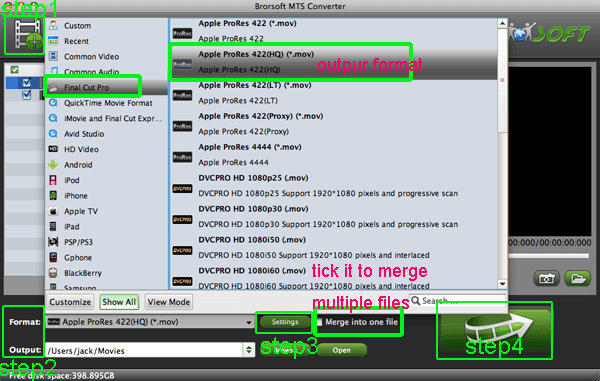lucy198754
Age: 42
Joined: 08 Dec 2011
Posts: 304
Location: USA


|
|
iDevice in its widest sense, is an unofficial general term that can refer to any mobile electronic devices marketed by Apple Inc. that start with "i", such as the iPod, iPhone, iPod Touch, and iPad,[1] or more specifically any of their devices (sometimes then referred to as iOS devices) that use the iOS operating system, such as the Apple TV. As we know, Apple also developed FCP, iMoive and FCE. In fact, most Mac users like to edit their videos including AVCHD/MTS/M2TS recordings from Camcorders in FCP, because it allows users to log and transfer video onto a hard drive (internal or external), where it can be edited, processed, and output to a wide variety of formats.
Here, I will tell FCP X users some Tips on editing AVCHD on Mac OS X. Sometimes, if you import AVCHD to FCP X for editing, you will meet some trouble like warning due to unknow format. Please remember it: The best video format is Apple ProRes MOV for FCP. In this article, I will take Sony SLT-A65 as an example and share my easy way to copy Sony A65 MTS to FCP X without rendering.
You need a top third Software to help you convert Sony A65 MTS to ProRes for FCP X. I am using Brorsoft MTS to FCP Converter. Because it transcodes sony 1080p MTS/M2TS files to ProRes for FCP X more easily and quicker that other converters do keeping original video quality. Besides that, it is equipped with some simple but useful editing features, such as merging several videos into one file, deinterlacing the original footages, cropping video size, trimming video clips, adding special effects and text/image/video watermarks to output videos. You can download it and follow me to have a try.
 
Guide: Tips on converting Sony A65 1080p AVCHD MTS to FCP X with best setting on Mac OS X.
Step1: Launch the best MTS Converter for FCP X and then click the adding button to import your AVCHD 1080p MTS/M2TS files. You can tick the box in front of the file you want to convert.
Tip: If you have multiple Sony SLT-A65 AVCHD 1080p MTS/M2TS files, you can select the “Merge into one” box.
Step 2: Click on the “Format” and get the dropdown menu, then move you pointer to “Final Cut Pro”. Here we recommend the Apple PreRes 422(HQ) if you give the priority to the quality of the converted videos. Then you can set the output folder by clicking “Browse” icon as you need.
Tips:
a. If you want the files to be in smaller size, you can follow Final Cut Pro>Apple ProRes 422(LT)(*mov)/Apple ProRes 422(*mov) option.
b. If your files size is at SD levels, you are advised to choose Final Cut Pro>Apple ProRes 422(Proxy)(*mov), which is recommended for 480i/p and 576i/p shootings as well.
Step 3: Click the “Settings” icon and you will go into a new interface named “Profile Settings”. You can adjust codec, bit rate, frame rate, sample rate and audio channel in the interface according to your needs and optimize the output file quality.
Note: You’d better set the video frame rate as 30fps, video size as 1920*1080 to keep the best quality for editing in Final Cut Pro. If you want to have a smaller file size but keep the good quality, you can change the video size to 1440*1080.
Step 4: Click the “Convert” button; it will transcode Sony MTS/M2TS to ProRes for FCP X on Mac OS Lion immediately. You can find the process in the “Conversion” interface.

After the fast Sony SLT-A65 MTS to FCP X conversion process, you will be able to get the output files for FCP by clicking on “Import” button effortlessly. Now you can easily transfer and edit Sony A65 MTS recordings in FCP X on Mac OS X without rendering.
Related Guide:
Import Sony Alpha NEX-5N AVCHD footages to FCP
Copy Sony A77 1080p MTS footgaes to iMovie
Sony A77 60p AVCHD to FCP 7
Copy Sony α NEX-7 AVCHD recordings to FCP X
|
|
|
|
|
|